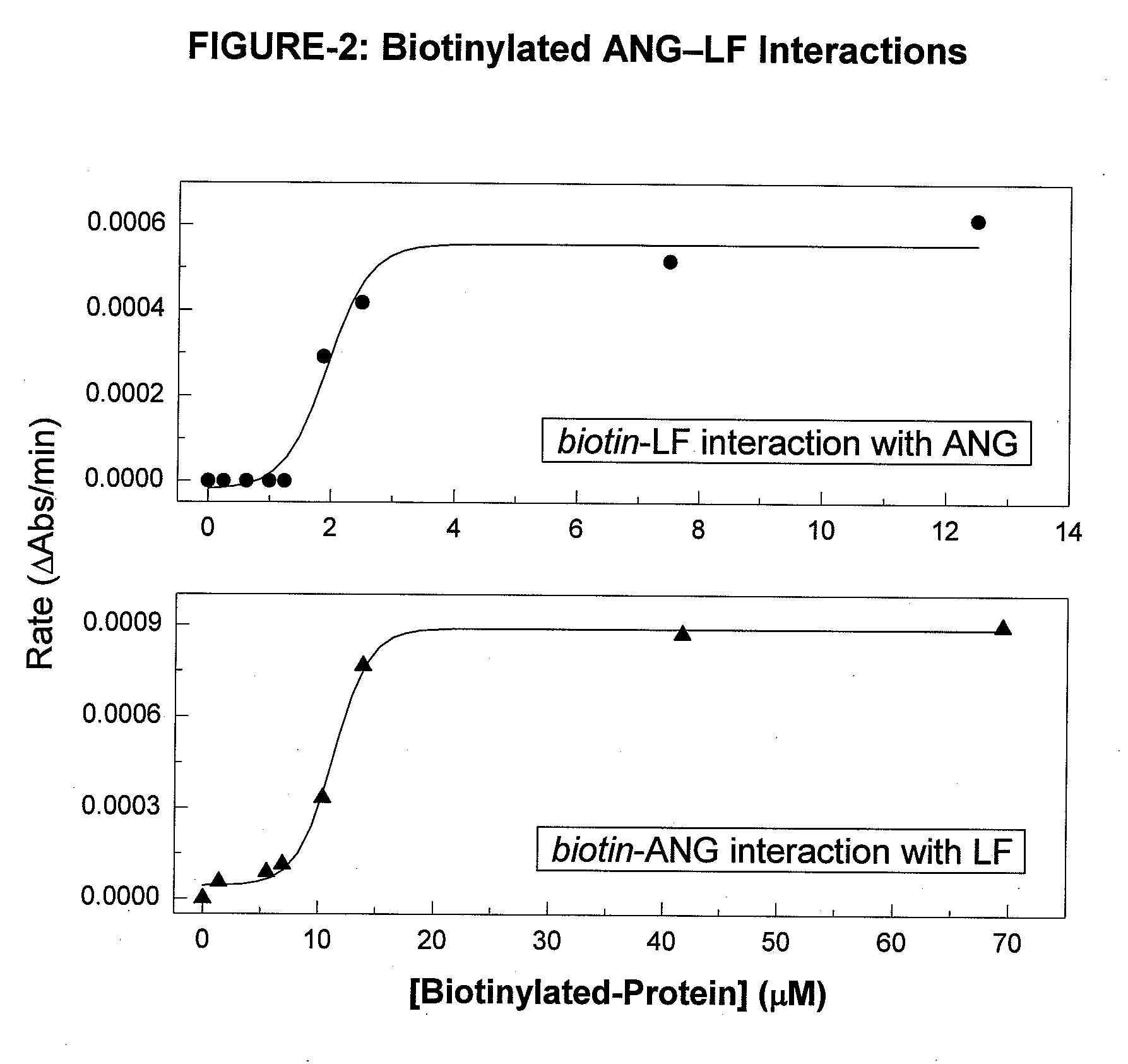ANGIOGENIN COMPLEXES (ANGex) AND USES THEREOF
a technology of angiogenin and complexes, applied in the field of protein stabilization, can solve the problems of broad-spectrum human health care, animal health applications, feed conversion, etc., and achieve the effect of enhanced and specific biological activity
- Summary
- Abstract
- Description
- Claims
- Application Information
AI Technical Summary
Benefits of technology
Problems solved by technology
Method used
Image
Examples
example-1
Angiogenin (ANG) Preparations
[0073]Bovine milk (6% fat, 3% protein) was concentrated 2-3 fold, by ultra-filtration through a polysulfonic membrane (pore size 30 kDa). ANG was isolated from the ultra-filtrate by precipitation of proteins with ammonium sulfate, followed by cation-exchange chromatography as previously described (Fedorova T V, et al., Appl. Biochem. Microbiol. 38:193-196, 2002). Briefly, the protein precipitated with 60% ammonium sulfate was dissolved in 0.01 M potassium phosphate buffer (pH 6.7) and dialyzed against the same buffer at 4° C. for 36 h. The dialysate was loaded on to a CM-cellulose 52 column (Serva, Germany) and 4-mL fractions were collected. Fractions with A280≧0.1 were pooled and dialyzed against 10 mM Tris-HCl buffer (pH 8.3). The dialyzate was then loaded on a CM-Toyopearl 650 S column (Tosoh, Japan) equilibrated with 0.05 M Tris-HCl buffer (pH 8.3). Column-bound proteins were eluted with a linear gradient of KCl concentration in the same buffer at a ...
example-2
Preparation of ANGex Using Carbohydrate-Based Substrates
[0079]ANG is immobilized on carbohydrate-based supports using reductive amination process that involves reactive aldehyde groups generated by partial hydrolysis of agarose (or agar). Acid hydrolysis of agar under mild conditions leads to cleavage of glycosidic bonds between C-1 of 3,6-anhydro-L-galactose and O-3 of D-galactose residues that exposes D-galactosyl residues and leads to the formation of galactose-rich polysaccharides (GRP) (Gray G. Arch. Biochem. Biophys. 163:426-428, 1974; Lee R T, et al., Biochemistry 19:156-163, 1980).
[0080]Galactose-rich polysaccharide (GRP), extracted as a water-soluble fraction from agar was used as the substrate for ANG immobilization. GRP was prepared by adding 1-g of bacteriological agar (Difco) to 10-mL of citrate-bicarbonate buffered saline [(CBS), pH 8.0; consisting of 1 mM citric acid, 10 mM NaHCO3, and 100 mM NaCl]. After thorough mixing on a vortex, the mixture was centrifuged for 2 ...
example-3
Preparation of ANGex Using Protein-Based Substrates
[0085]ANG was immobilized on protein substrates via non-covalent interactions and conjugation methods including biotin-avidin affinity binding and disulfide bonding techniques. Suitable functional protein substrates: i) physiological transport-proteins including but not limited to lactoferrin, transferrin, ovo-transferrin (conalbumin), ceruloplasmin, metallo-thionein and transfer factors; ii) sub-epithelial matrix proteins including but not limited to fibronectin, fibrinogen, laminin, vitronectin, osteopontin, native collagens and denatured collagen (gelatin); iii) antimicrobial proteins including but not limited to peroxidases (lactoperoxidase, LPO; myeloperoxidase, MPO; and salivary peroxidase, SPO) and lysozyme.
Measurement of Biotinylated-ANG and LF Interactions by ELISA.
[0086]For binding studies, a 1% LF substrate (cow milk protein isolate) was prepared in 20 mM sodium acetate buffer (pH 4.0). A 1% LF solution (volume: 0.1-mL) w...
PUM
| Property | Measurement | Unit |
|---|---|---|
| concentrations | aaaaa | aaaaa |
| concentrations | aaaaa | aaaaa |
| concentrations | aaaaa | aaaaa |
Abstract
Description
Claims
Application Information
 Login to View More
Login to View More - R&D
- Intellectual Property
- Life Sciences
- Materials
- Tech Scout
- Unparalleled Data Quality
- Higher Quality Content
- 60% Fewer Hallucinations
Browse by: Latest US Patents, China's latest patents, Technical Efficacy Thesaurus, Application Domain, Technology Topic, Popular Technical Reports.
© 2025 PatSnap. All rights reserved.Legal|Privacy policy|Modern Slavery Act Transparency Statement|Sitemap|About US| Contact US: help@patsnap.com



